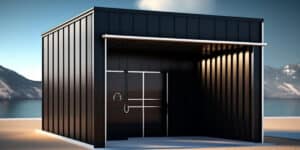Building a Garage That Stands Out: The Benefits of Using Shipping Containers
When it comes to building a garage, many people opt for traditional construction methods using bricks, wood, or concrete. However, there is a rising trend in using shipping containers as a unique and innovative alternative. Not only do shipping containers provide a modern and stylish look, but they also offer numerous benefits that make them a standout choice for garage construction.
Sustainability and Eco-Friendliness
One of the major advantages of using shipping containers for building a garage is their sustainability. By repurposing containers that would otherwise go to waste, you are contributing to the reduction of environmental impact. With the growing concern for sustainable practices, using shipping containers aligns with the principles of recycling and upcycling.
Additionally, shipping containers are made from durable materials such as steel, which makes them resistant to harsh weather conditions. This durability ensures that your garage will stand the test of time, reducing the need for frequent maintenance or rebuilding.
Cost-Effectiveness
Another benefit of using shipping containers for your garage is cost-effectiveness. Building a garage from scratch can be an expensive endeavor, requiring materials, labor, and time. Shipping containers, on the other hand, are readily available at a fraction of the cost of traditional building materials.
Moreover, the modular nature of shipping containers allows for easy customization and expansion. You can start with a single container and add more as needed, saving you money on initial construction costs. This flexibility makes shipping containers a cost-effective option for those looking to build a garage on a budget.
Quick and Efficient Construction
Traditional garage construction can take weeks, if not months, to complete. On the contrary, using shipping containers significantly reduces construction time and allows for a quick setup. Shipping containers are already designed for transportation and stacking, making them easy to install and assemble.
Additionally, since containers are pre-built structures, they require minimal on-site labor. This not only saves time but also reduces the risk of construction delays caused by adverse weather conditions. With shipping containers, you can have your garage up and running in no time, providing you with convenience and functionality without the long wait.
Versatility and Customization Options
Shipping containers offer a wide range of customization options, allowing you to design a garage that meets your specific needs and aesthetic preferences. Containers can be modified to include windows, doors, insulation, electrical wiring, and plumbing. You can also choose from various container sizes, giving you the flexibility to create a garage space that suits your requirements.
Moreover, shipping containers can be easily transformed into multi-purpose spaces. If you need more than just a garage, you can create a hybrid structure that combines storage, workshop, or even living space. The versatility of shipping containers gives you the freedom to think outside the box and create a unique garage that stands out from the crowd.
Conclusion
Building a garage using shipping containers offers a range of benefits that make it a compelling choice for those looking for a standout and cost-effective solution. From sustainability and eco-friendliness to quick construction and versatility, shipping containers provide a modern and customizable option for creating a garage space that truly stands out. So, why settle for a traditional garage when you can embrace the uniqueness and innovation of shipping container construction?
From Storage to Style: The Ultimate Guide to Building a Shipping Container Garage
Are you in need of extra space for your vehicles or a workshop for your DIY projects? Look no further than a shipping container garage! Not only are shipping containers an affordable and versatile option, but they also add a unique and modern touch to your property. In this ultimate guide, we will walk you through the steps to transform a shipping container into a functional and stylish garage.
Step 1: Choosing the Right Container
The first step in building a shipping container garage is to select the right container for your needs. Consider the size and condition of the container. Generally, containers come in standard sizes of 20 or 40 feet long, 8 feet wide, and 8.5 feet high. Choose a size that accommodates your vehicles and allows for additional storage or workspace. It is also important to inspect the container for any structural damage or rust before making a purchase.
Step 2: Site Preparation
Before you start the construction process, you need to prepare the site where your shipping container garage will be located. Clear the area of any debris or obstructions and ensure that the ground is level. It is advisable to lay a foundation or concrete pad to provide a solid and stable base for the container.
Step 3: Insulation and Ventilation
To ensure that your shipping container garage is comfortable, insulated, and well-ventilated, it is crucial to insulate the interior walls and ceiling. This will help regulate the temperature and prevent condensation. You can use spray foam insulation or install insulating panels. Additionally, consider installing windows or vents to allow for proper air circulation.
Step 4: Electrical and Plumbing
If you plan to use your shipping container garage as a workshop, you will need to install electrical outlets, lighting fixtures, and potentially plumbing for water supply. It is recommended to hire a professional electrician and plumber to ensure that all installations are done safely and up to code.
Step 5: Flooring and Finishing Touches
When it comes to flooring, there are several options to consider. You can choose to keep the original container flooring, which is typically made of marine-grade plywood. Alternatively, you can install a more durable and stylish flooring material such as epoxy coating, rubber tiles, or laminate flooring.
To add a touch of style and functionality to your shipping container garage, consider painting the exterior in a color that complements your property. Add windows, skylights, or a roll-up garage door for natural light and easy access. You can also incorporate shelving units, workbenches, and storage solutions to maximize the functionality of your space.
Step 6: Security Measures
Finally, don’t forget to prioritize security for your shipping container garage. Install sturdy locks on the doors and windows to keep your vehicles and belongings safe. Consider adding security cameras or an alarm system for added protection.
Conclusion
Transforming a shipping container into a garage is a cost-effective and stylish way to create extra space on your property. By following these steps, you can build a functional and attractive shipping container garage that meets all your storage and workshop needs. Whether you’re a car enthusiast, a hobbyist, or simply in need of more space, a shipping container garage is a practical and trendy solution. Get creative, unleash your DIY skills, and build the garage of your dreams!
Container Conversion: The Modern Solution for Creating a Unique Garage Space
Garages have long been a staple in residential properties, serving as a space to store vehicles, tools, and other items. But in recent years, homeowners have been seeking creative ways to transform their garages into something more than just a storage space. From home offices to workout studios, garages are being converted into functional and personalized areas that cater to individual needs.
One of the most popular trends in garage conversion is the use of shipping containers. These large, durable metal containers have become a go-to solution for creating unique and versatile garage spaces. With their sturdy construction and modular design, shipping containers offer endless possibilities for customization.
Advantages of Container Conversions
Container conversions offer several advantages over traditional garage renovations. Here are a few reasons why homeowners are opting for this modern solution:
Affordability
Container conversions are often more cost-effective compared to traditional garage renovations. The price of shipping containers is relatively low, especially when compared to the cost of building a new structure from scratch. Additionally, the modular design of containers allows for easy customization, eliminating the need for extensive construction work and reducing labor costs.
Durability and Security
Shipping containers are designed to withstand harsh conditions during transportation, making them incredibly durable. These metal structures are resistant to fire, pests, and extreme weather conditions, ensuring that your converted garage space remains safe and secure. With proper insulation and ventilation, containers can provide a comfortable environment for various uses.
Versatility
One of the key advantages of container conversions is their versatility. Containers can be easily modified and adapted to suit a wide range of purposes. Whether you want to create a home gym, an art studio, or a workshop, containers can be customized to meet your specific needs. Their modular design allows for easy installation of windows, doors, insulation, and electrical systems, making the transformation process hassle-free.
Eco-Friendly Option
Container conversions are also an eco-friendly choice for homeowners. By repurposing shipping containers, you are reducing waste and giving new life to a structure that would otherwise be discarded. Additionally, containers can be outfitted with sustainable features such as solar panels and rainwater harvesting systems, further reducing your environmental footprint.
Tips for a Successful Container Conversion
If you’re considering a container conversion for your garage, here are a few tips to ensure a successful transformation:
- Plan and Research: Before diving into a container conversion project, thoroughly plan and research the design, layout, and necessary permits. Understand the local building codes and regulations to ensure compliance.
- Consider Insulation: Proper insulation is essential to maintain a comfortable temperature inside the container. Insulate the walls, ceiling, and floor to prevent heat loss or gain. This will help create a habitable space regardless of the external climate.
- Maximize Natural Light: Shipping containers can feel dark and confined due to their limited window openings. To create a bright and inviting space, consider adding additional windows or skylights. This will not only improve the aesthetics but also enhance the overall functionality of the converted garage.
- Prioritize Ventilation: Adequate ventilation is crucial for airflow and moisture control. Install vents or fans to prevent condensation, mold, and unpleasant odors. Proper ventilation will ensure a healthy and comfortable environment inside the converted space.
- Customize to Your Needs: Container conversions offer endless possibilities for customization. Tailor the interior layout, storage solutions, and fixtures to fit your specific needs. Consider incorporating shelving, workbenches, or built-in storage units to optimize space utilization.
Conclusion
Container conversions provide homeowners with a modern and unique solution for creating a personalized garage space. With their affordability, durability, versatility, and eco-friendly nature, shipping containers offer endless possibilities for transforming your garage into a functional and stylish area that suits your individual needs. By following some key tips and guidelines, you can successfully convert a shipping container into a one-of-a-kind garage space that exceeds your expectations.
Revolutionize Your Garage Space: How to Build a Shipping Container Garage
Are you looking to add extra storage space or create a unique workshop area in your backyard? Look no further than the innovative solution of building a shipping container garage. Not only are shipping containers durable and cost-effective, but they also offer endless possibilities for customization. In this blog post, we will guide you through the steps of revolutionizing your garage space by building a shipping container garage.
Step 1: Find the Perfect Location
Before you start your shipping container garage project, you need to determine the ideal location for it. Consider factors such as accessibility, sun exposure, and the overall layout of your backyard. Ensure that the area you choose can accommodate the size of the shipping container you plan to use and meets any local regulations or building codes.
Step 2: Select the Right Container
Shipping containers come in various sizes, including 20-foot, 40-foot, and even larger options. Choose the container size that suits your needs and fits well within your chosen location. It’s also essential to inspect the container for any structural damage or rust before making a purchase. Look for containers that are wind and watertight to ensure the longevity and durability of your new garage.
Step 3: Prepare the Site
Clear the area where you plan to install your shipping container garage. Level the ground and create a solid and stable foundation, such as a concrete pad or a gravel base. This will provide a secure base for your container and prevent any shifting or settling over time.
Step 4: Modify the Container
One of the most exciting aspects of building a shipping container garage is the ability to customize it to fit your specific needs. Decide on the modifications you want to make, such as adding windows, doors, or ventilation systems. You may also want to insulate the container to regulate temperature and make it more comfortable.
Consult with a professional contractor or architect who specializes in shipping container conversions to ensure that the modifications are done correctly and safely. They can offer expert advice and help you navigate any potential challenges that may arise during the modification process.
Step 5: Install Utilities
To make your shipping container garage functional, you will need to install utilities such as electricity, plumbing, and heating or cooling systems. This step may require the expertise of licensed professionals, so be sure to consult with them before proceeding.
Consider your specific needs when designing the utility layout. Will you need a sink or bathroom? How many electrical outlets will be necessary for your workshop or storage space? Planning ahead will ensure that your shipping container garage meets all your requirements.
Step 6: Enhance Security
As with any garage or storage space, security is a top priority. Take measures to enhance the security of your shipping container garage. Install sturdy locks, security cameras, and motion sensor lights to deter any potential intruders.
Step 7: Personalize Your Space
Now that you’ve built the foundation of your shipping container garage, it’s time to make it your own. Add your personal touch by painting the exterior with your favorite colors or adding custom decals. Create a functional and organized interior with shelves, workbenches, and storage systems. Let your creativity flow and transform your shipping container garage into a space that reflects your personality and meets your specific needs.
Conclusion
Building a shipping container garage is an excellent way to revolutionize your garage space. With their durability, affordability, and endless customization options, shipping containers offer a unique and practical solution for additional storage or workshop areas. By following the steps outlined in this blog post, you can successfully create a shipping container garage that is both functional and visually appealing. So, why wait? Start planning your shipping container garage project today and unlock the full potential of your garage space.
Thinking Outside the Box: Transforming a Shipping Container into a Garage
In the world of innovative housing solutions, shipping container homes have gained significant popularity over the years. These metal boxes, originally designed for transporting goods across the globe, have proven to be versatile and cost-effective building materials for creating unique living spaces. However, their potential doesn’t stop at residential projects. One particularly creative and practical use for shipping containers is transforming them into garages.
The Appeal of Shipping Container Garages
Cost-Effective and Time-Efficient
One of the main advantages of using shipping containers as garages is the cost-effectiveness. Compared to traditional garage construction, repurposing a shipping container can save you a significant amount of money. The containers are readily available and relatively inexpensive to purchase, especially if you opt for used ones. Additionally, modifying a container into a garage requires less time and labor, allowing you to have a functional space in a shorter timeframe.
Durability and Security
Shipping containers are designed to withstand harsh weather conditions and the wear and tear of long journeys at sea. They are built to be sturdy and secure, providing excellent protection for your vehicles and belongings. The solid metal structure makes it difficult for intruders to break into, giving you peace of mind knowing that your garage is a safe space.
Versatility and Customization
The beauty of transforming a shipping container into a garage lies in its versatility. These containers come in various sizes, allowing you to select the perfect dimensions for your needs. Whether you have one car or multiple vehicles, there is a container size that can accommodate them. Moreover, containers can be easily modified to include windows, doors, ventilation systems, electrical wiring, and insulation to suit your preferences and requirements.
Portability
Another interesting aspect of using shipping containers as garages is their portability. Unlike traditional garages, which are fixed structures, containers can be transported to different locations if needed. This feature is particularly useful if you move houses frequently or if you have a business that requires temporary storage or workshop facilities. You can simply load up the container onto a truck and transport it wherever you go.
Transforming a Shipping Container into a Garage
Planning and Preparation
Before embarking on your shipping container garage project, thorough planning is essential. Start by determining the size of the container you need, keeping in mind the number and size of vehicles you want to store. Consider the available space on your property and any local regulations or permits required for the installation.
Insulation and Climate Control
To create a comfortable environment for your vehicles, insulation is crucial. Shipping containers are typically made of metal, which can lead to extreme temperature fluctuations inside. Insulating the walls and ceiling will help regulate the temperature and prevent condensation. Additionally, installing proper ventilation and heating or cooling systems will ensure that your garage remains comfortable year-round.
Electrical and Lighting
To make your container garage functional, you’ll need to install electrical wiring and lighting. This will allow you to power tools, charge your vehicles, and illuminate the space adequately. Hiring a professional electrician is recommended to ensure the safety and compliance of the electrical setup.
Doors, Windows, and Security
Choose durable and secure doors for easy access to your garage. Roll-up doors are a popular choice as they save space and provide a secure barrier. Windows can be added to bring in natural light and improve ventilation. It’s important to invest in sturdy locks and security systems to protect your vehicles and belongings.
Flooring and Storage
Consider the type of flooring that best suits your needs. Depending on your budget and preferences, options range from simple concrete to epoxy coatings. Additionally, installing shelves, hooks, and storage cabinets will help keep your garage organized and maximize the use of space.
Conclusion
Repurposing a shipping container into a garage is an innovative and practical solution for those seeking a cost-effective, durable, and customizable space to store their vehicles. With careful planning and the right modifications, you can transform a simple metal box into a functional and stylish garage that not only protects your vehicles but also adds a unique touch to your property. So, think outside the box and consider the potential of shipping containers for your next garage project!




